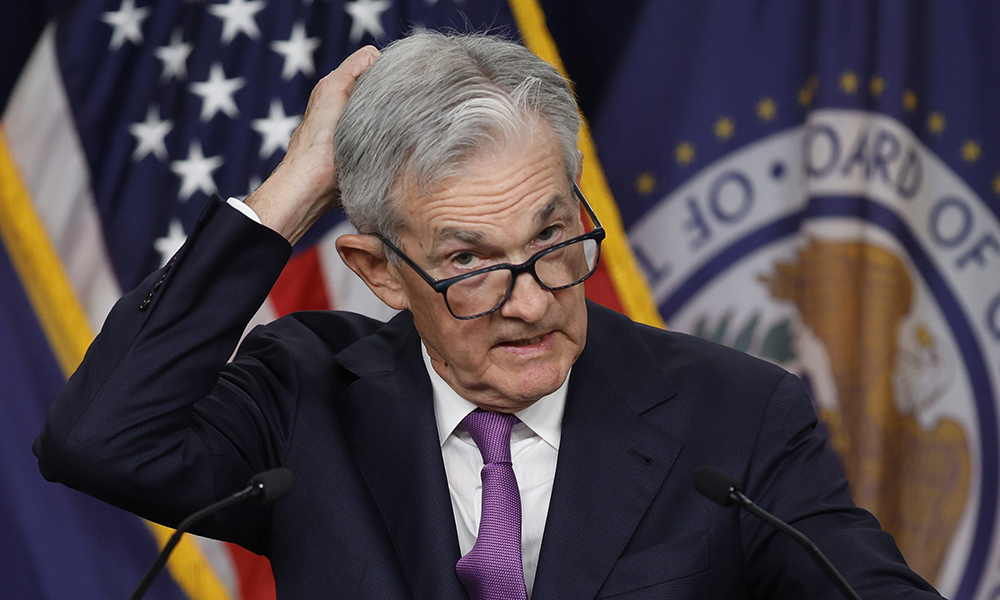9月美国加息效果不佳,批发通胀创4月以来最快上涨速度

上个月,美国的批发物价达到了自4月以来的最快上涨速度。这表明尽管美国已经进行了一年半的加息,通胀压力仍然存在。
美国劳工部(Labor Department)周三报告称,美国的生产物价指数同比上涨2.2%。生产物价指数衡量进入消费环节之前的通胀。8月,该指数已经上涨了2%。
从8月到9月,生产物价环比上涨0.5%,低于从7月到8月0.7%的涨幅。
在9月份,剔除了容易波动的食品和能源价格后,核心通胀同比上涨了2.7%,较8月上涨0.3%。美联储以及众多外部经济学家特别关注核心物价,将其视为预测通胀走势的可靠信号。
批发物价的上涨幅度一直低于消费物价。随着生产者将成本传递给消费者,这增加了通胀持续下降的希望。但受到商品价格上涨的影响,周三公布的上个月数据却高于经济学家的预期。上个月,批发食品价格较8月上涨了0.9%,而从7月到8月批发食品价格下跌了0.5%。
去年,通胀达到了四十年来的最高水平,这促使美联储采取激进的加息措施。自2022年3月以来,美国央行已经11次提高了基准利率。更高的借款成本确实有助于抑制通胀,并导致依然稳固的就业市场增长放缓。
有越来越多人预测,美联储在今年剩余时间可能不会调整利率。周一,两位美联储官员表示,在三周后召开的央行会议上,美联储可能不会调整关键利率,这番言论帮助刺激了债市和股市上涨。
高频经济(High Frequency Economics)首席美国经济学家比埃拉·法鲁奇表示,上个月更高的生产物价“可能不会改变美联储的政策前景。我们的基准情景依旧是美联储将维持高利率。对于美联储而言,地缘政治发展是一个额外的风险因素,这可能让政策制定者未来继续保持谨慎。”
与此同时,美国经济的表现比预期的更加坚挺。越来越多的人乐观地认为美联储能够实现“软着陆”,即加息足以控制通货膨胀,但不会导致经济陷入严重衰退。
美国劳工部将在周四发布备受关注的9月份消费物价指数。上个月,该部门公布的数据显示,与一年前相比,8月的核心消费物价创下近两年来的最小涨幅。(财富中文网)
翻译:刘进龙
审校:汪皓
上个月,美国的批发物价达到了自4月以来的最快上涨速度。这表明尽管美国已经进行了一年半的加息,通胀压力仍然存在。
美国劳工部(Labor Department)周三报告称,美国的生产物价指数同比上涨2.2%。生产物价指数衡量进入消费环节之前的通胀。8月,该指数已经上涨了2%。
从8月到9月,生产物价环比上涨0.5%,低于从7月到8月0.7%的涨幅。
在9月份,剔除了容易波动的食品和能源价格后,核心通胀同比上涨了2.7%,较8月上涨0.3%。美联储以及众多外部经济学家特别关注核心物价,将其视为预测通胀走势的可靠信号。
批发物价的上涨幅度一直低于消费物价。随着生产者将成本传递给消费者,这增加了通胀持续下降的希望。但受到商品价格上涨的影响,周三公布的上个月数据却高于经济学家的预期。上个月,批发食品价格较8月上涨了0.9%,而从7月到8月批发食品价格下跌了0.5%。
去年,通胀达到了四十年来的最高水平,这促使美联储采取激进的加息措施。自2022年3月以来,美国央行已经11次提高了基准利率。更高的借款成本确实有助于抑制通胀,并导致依然稳固的就业市场增长放缓。
有越来越多人预测,美联储在今年剩余时间可能不会调整利率。周一,两位美联储官员表示,在三周后召开的央行会议上,美联储可能不会调整关键利率,这番言论帮助刺激了债市和股市上涨。
高频经济(High Frequency Economics)首席美国经济学家比埃拉·法鲁奇表示,上个月更高的生产物价“可能不会改变美联储的政策前景。我们的基准情景依旧是美联储将维持高利率。对于美联储而言,地缘政治发展是一个额外的风险因素,这可能让政策制定者未来继续保持谨慎。”
与此同时,美国经济的表现比预期的更加坚挺。越来越多的人乐观地认为美联储能够实现“软着陆”,即加息足以控制通货膨胀,但不会导致经济陷入严重衰退。
美国劳工部将在周四发布备受关注的9月份消费物价指数。上个月,该部门公布的数据显示,与一年前相比,8月的核心消费物价创下近两年来的最小涨幅。(财富中文网)
翻译:刘进龙
审校:汪皓
U.S. wholesale prices rose last month at the fastest pace since April, suggesting that inflationary pressures remain despite a year and a half of higher interest rates.
The Labor Department reported Wednesday that its producer price index — which measures inflation before it hits consumers — climbed 2.2% from a year earlier. That was up from a 2% uptick in August.
On a month-to-month basis, producer prices rose 0.5% from August to September, down from 0.7% from July to August.
Excluding volatile food and energy prices, so-called core inflation rose 2.7% in September from a year earlier and 0.3% from August. The Federal Reserve and many outside economists pay particular attention to core prices as a good signal of where inflation might be headed.
Wholesale prices have been rising more slowly than consumer prices, raising hopes that inflation may continue to ease as producer costs make their way to the consumer. But Wednesday’s numbers, driven by an uptick in the price of goods, came in higher last month than economists had expected. Wholesale food prices rose 0.9% last month from August after tumbling 0.5% from July to August.
Last year, inflation reached highs not seen in four decades, prompting the Fed to raise interest rates aggressively. The central bank has boosted its benchmark rate 11 times since March 2022. Those higher borrowing costs have helped cool inflation and slow a still-solid job market.
There are growing expectations that the Fed may decide to leave interest rates alone for the rest of the year. On Monday, two Fed officials suggested that the central bank may leave its key rate unchanged at its next meeting in three weeks, helping touch off a rally in bonds and stocks.
Rubeela Farooqi, chief U.S. economist at High Frequency Economics, said last month’s higher producer prices “likely do not change the outlook for Fed policy. Our baseline remains that rates are at a peak. For the Fed, geopolitical developments will be an additional risk factor which will likely keep policymakers proceeding cautiously going forward.″
In the meantime, the economy has remained sturdier than expected. Optimism is rising that the Fed may pull off a ”soft landing” — raising rates just enough to tame inflation without tipping the economy into a deep recession.
On Thursday, the Labor Department will issue its closely watched consumer price index for September. Last month, the department reported that compared with 12 months earlier, core consumer prices in August rose at the smallest pace in nearly two years.













